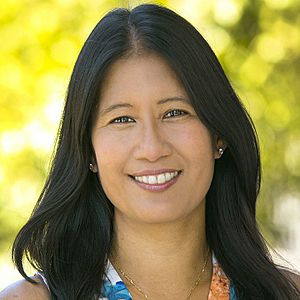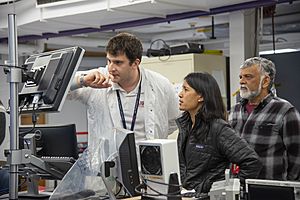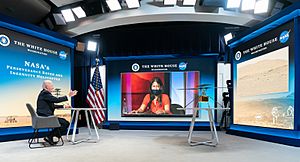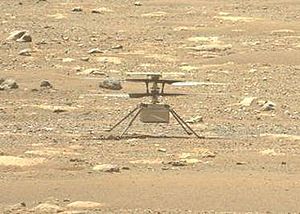MiMi Aung facts for kids
Quick facts for kids
MiMi Aung
|
|
|---|---|
| မိမိအောင် | |
 |
|
| Born | 1968 (age 56–57) |
| Education | Grainger College of Engineering, University of Illinois at Urbana–Champaign (BSEE, MS) |
| Known for | Project lead for Mars Helicopter Ingenuity, which made the first extraterrestrial powered, controlled flight on April 19, 2021 |
| Children | 2 |
| Awards | 100 Women, member of the National Academy of Engineering |
| Scientific career | |
| Fields | Electrical engineering, space science |
| Institutions | NASA Jet Propulsion Laboratory, Amazon Kuiper Systems |
MiMi Aung (born in 1968) is an amazing engineer from Myanmar and the United States. She is known for her work on the Mars Helicopter Ingenuity. This helicopter made history by flying on Mars.
Currently, MiMi Aung helps lead a big project at Amazon called Project Kuiper. This project aims to bring internet to more people. It uses many satellites orbiting Earth.
MiMi Aung was born in the United States. Her family moved back to Myanmar when she was two. She spent her childhood there and in Malaysia. At age 16, she returned to the U.S. She studied engineering at the University of Illinois at Urbana-Champaign. There, she earned her bachelor's and master's degrees.
In 1990, she joined NASA's Jet Propulsion Laboratory (JPL). She became a lead engineer for the Mars Helicopter Ingenuity. This was the first aircraft to fly on another planet. Ingenuity landed on Mars on February 18, 2021. Its first flight happened on April 19, 2021. It lasted 39 seconds. MiMi Aung said it was "an incredible moment." She added, "This morning our dream came true." People compared this flight to the first flight by the Wright brothers in 1903. A small piece of the Wright brothers' plane was even carried to Mars by Ingenuity.
Contents
Early Life and Family
MiMi Aung's parents met in the United States. They were both studying for their advanced degrees. Her mother, Hla Hla Sein, was the first woman from Myanmar to earn a high degree in mathematics. Her father, Thein Aung, earned his degree in chemistry.
MiMi Aung was born in Illinois. She moved back to Myanmar with her parents when she was two and a half years old. When she was 11, her family moved to Malaysia. She went to St. Christopher's School there. At 16, her parents arranged for her to return to the U.S. She stayed with friends in Illinois to finish her education. Her two younger sisters were not born in the U.S. and could not move there.
MiMi Aung is married and has two children.
Education
MiMi Aung was interested in mathematics from a young age. She studied electrical engineering at the University of Illinois at Urbana–Champaign. She earned her bachelor's degree there. Then, she got her master's degree in 1990. Her master's work focused on communications and signal processing.
During her master's program, she learned about JPL's work. A professor told her about their deep space exploration projects. This work was connected to signal processing.
Research and Career
Working at NASA's JPL
In 1990, MiMi Aung started working at JPL. She worked on many projects. These projects were about spaceflight and the NASA Deep Space Network (DSN).
Deep Space Network (DSN)
MiMi Aung began her career working on the DSN. The DSN is a system of giant antennas. It helps NASA communicate with spacecraft far away. She helped develop and test special computer programs for the DSN. She set up these digital systems at the three DSN locations around the world.
Later, she worked on monopulse radar systems. These systems were used with the DSN's large antennas. She also worked on a special device called a radiometer. This device was for a satellite that studied Earth's atmosphere.
MiMi Aung's next project was called StarLight. It involved two spacecraft working together. She designed a sensor that helped them fly in formation. She was also chosen to manage a part of the Terrestrial Planet Finder (TPF) project. However, funding for TPF was stopped in 2006. The project was later canceled in 2011.
In 2003, MiMi Aung became a supervisor. She led a group that created sensor technologies for space missions. She became very interested in spacecraft that could explore on their own. In 2010, she became the manager of that section. She was also part of the team for the Psyche spacecraft. In 2013, she became the Deputy Manager of the Autonomous Systems Division.
Leading the Mars Helicopter Project
Since 2015, MiMi Aung led the team for the Mars helicopter. She oversaw the team that designed, built, tested, and flew Ingenuity. Other key team members included chief engineer Bob Balaram and chief pilot Håvard Grip.
The air on Mars is very thin. It is only about 1% as thick as Earth's atmosphere. So, a big challenge was how to make the helicopter fly. Ingenuity had to be very light. Its blades also had to spin much faster than they would on Earth. Also, people on Earth could not control the helicopter directly. Radio signals take too long to travel to Mars. So, JPL engineers gave Ingenuity a computer system. This system allowed it to fly and navigate by itself.
The first flight tests for the Mars Helicopter happened in early 2019. They took place inside a special space simulator at JPL. The helicopter cost about $23 million to build. It weighed less than 1.8 kilograms (about 4 pounds).
The helicopter was attached to the belly of the Perseverance rover. It launched from Cape Canaveral in Florida on July 30, 2020. This was part of NASA's Mars 2020 mission. The rover landed safely on Mars on February 18, 2021. Two days later, JPL received its first report from Ingenuity. The helicopter was successfully set down on the Martian surface on April 3, 2021.
Ingenuity's Mars Flights
On April 19, 2021, Ingenuity made history. It completed the first powered, controlled flight by an aircraft on another planet. The team at JPL confirmed the flight was a success. They received data from the helicopter through the rover.
The helicopter finished its main mission after three successful flights. For its first flight, Ingenuity took off. It climbed about 10 feet (3 meters) into the air. It hovered briefly, turned, and then landed. After that, the helicopter performed more experimental flights. These flights went farther and higher. Ingenuity operated on Mars for over 1,000 Martian days (sols). It was retired in early 2024. All four of its rotor blades were damaged.
Moving to Amazon Kuiper Systems
In July 2021, MiMi Aung left JPL after 30 years. She took on a new role at Amazon's Kuiper Systems. She is now the director of technical program management there. This project aims to improve internet access for communities worldwide. It uses a network of satellites orbiting close to Earth.
Awards and Public Engagement
MiMi Aung has received many honors for her achievements:
- She was named one of the top 100 Women in the world by the BBC in 2019.
- TIME Magazine named her one of the 100 Most Influential People of 2021.
- In 2022, she became a member of the National Academy of Engineering (NAE). This is America’s top engineering organization. It advises the government on science and technology. Members are chosen by other engineers. MiMi Aung was recognized for her pioneering work on the NASA Mars Helicopter. She was honored for the first flight on another planet.
- The University of Illinois gave her the 2022 Distinguished Alumni Award. This was for her technical work and leadership on the Ingenuity helicopter.
- In 2025, she was awarded the Prix international d’astronautique by the Société astronomique de France.
MiMi Aung is an expert for The Planetary Society. She has also written for Spaceflight magazine.
While the helicopter was being built, MiMi Aung put a webcam in the special clean room at JPL. This allowed the public to watch the team's progress.
MiMi Aung was also featured in the 2019 documentary Space Queens. This film showed several women who were inspired by the Apollo 11 mission. The film mentioned her work on the Mars 2020 project and the Ingenuity helicopter.
On April 24, 2023, MiMi Aung gave a speech at Harvard University. Her talk, "The Sky’s Not the Limit: My Journey into Space Exploration and STEM," shared her personal story as a space engineer.
See also
 In Spanish: MiMi Aung para niños
In Spanish: MiMi Aung para niños




